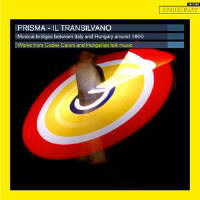Texte paru dans: / Appeared in: |
||||
|
Outil de traduction ~ (Trčs approximatif) |
||||
|
Reviewer: James
V. Maiello There seems to be an encouraging profusion of young early music performers these days, which bodes very well for the future. Ostensibly based in Germany, Prisma is a quartet focused primarily on 17th- and 18th-century music. Its members have built the present program around connections between Hungary and Italy around 1600, in particular the Codex Caioni. The manuscript, which contains an anthology of Italian and German music alongside Romanian and Hungarian popular music, was rediscovered in 1988. Like the manuscript, Prisma’s disc places art and vernacular music side by side, and to striking effect. The program begins with a toccata by Dávid Budai, modeled on Italian organ works of the period. It is a fitting tribute to Giralamo Diruta, whose organ treatise bore a dedication to Prince Sigismund Báthory of Transylvania. This is followed by a traditional Hungarian song, a Hajnali, which is characterized by its flexibility and recitative-lie quality. Budai plays a folk viola here, its penetrating tone pulling thready lines over a drone-like accompaniment. Orazio Tarditi’s sonata La Romana survives only in the Codex Caioni. This rendering features Elizabeth Champollion as a recorder soloist, navigating both lively passagework and lyrical lines deftly. Among the highlights of the recording is a highly stylized saraband by Gesner. The players adopt an unusually lively tempo, and the plucked strings providing an earthy complement to the sheen of the bowed ones and the winds. This leads seamlessly into another sonata, this one by Biagio Marini, which receives a similarly spirited reading. Champollion performs an atmospheric improvisation on the kaval, an end-blown flute common in eastern European folk music. This serves as a kind of prelude to another traditional Hungarian song, Magos Kösziklának, which dates from as early as the 16th century. Franciska Hajdu’s voice is delicate and clear, complemented beautifully by the archlute. Two dances by Picchi are rounded out by a galliard in a matching style composed by Budai. Budai, here and in the opening toccata, shows a deep understanding of these styles and idioms, and the performances of all three are sparkling. A set of three more Hungarian folksongs ushers in a brisk section of the program, full of infectious rhythms and virtuosic playing all around. An intrada from the Codex Caioni returns to art music. A “Hungarian” suite by Mainerio is one of the most substantial items on the program, followed by another toccata by Budai that would be completely at home in the Codex Caioni. The remainder of the album is devoted to Hungarian folk songs and dances. The whole program lasts less than an hour, but it covers an astonishing amount of ground, with representations of a wide range of art and vernacular music, played and sung expertly. That this music is rarely heard is simply an added benefit.
| ||||
|
||||
|
|
|
|||
|
Cliquez l'un ou l'autre
bouton pour découvrir bien d'autres critiques de CD |
||||




